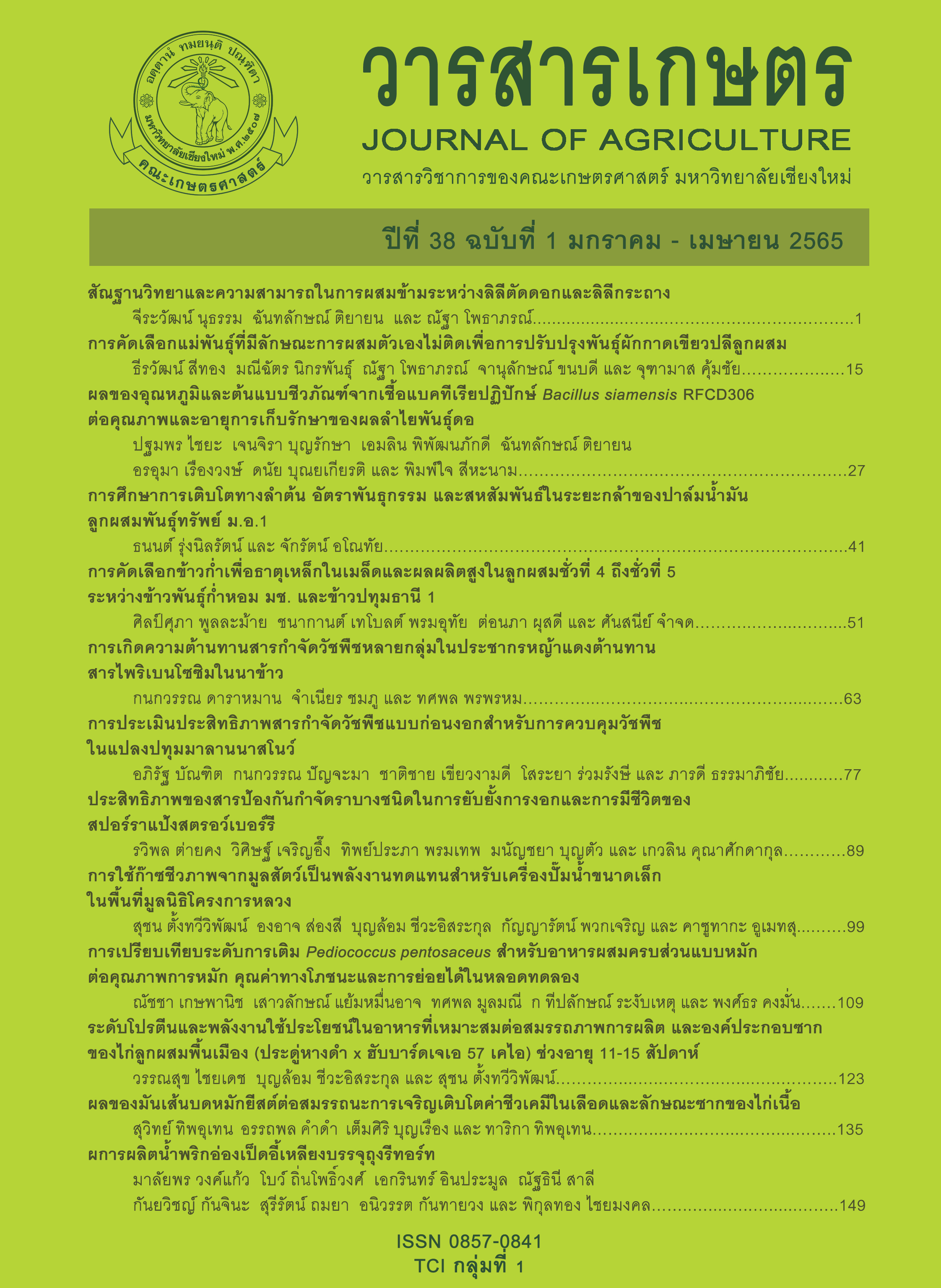ผลของอุณหภูมิและต้นแบบชีวภัณฑ์จากเชื้อแบคทีเรียปฏิปักษ์ <I> Bacillus siamensis </I> RFCD306 ต่อคุณภาพและอายุการเก็บรักษาของผลลำไยพันธุ์ดอ
Main Article Content
บทคัดย่อ
การวิจัยครั้งนี้มีวัตถุประสงค์เพื่อศึกษาผลของอุณหภูมิและต้นแบบชีวภัณฑ์สูตรแป้งข้าวเจ้า - 2 จากเชื้อแบคทีเรียปฏิปักษ์ Bacillus siamensis ไอโซเลท RFCD306 (อัตราการใช้ 0.5 กรัมต่อน้ำ 100 มิลลิลิตร) ต่อคุณภาพและอายุการเก็บรักษาผลลำไยพันธุ์ดอ โดยวางแผนการทดลองแบบสุ่มสมบูรณ์ ประกอบด้วย 6 กรรมวิธี ได้แก่ กรรมวิธีที่ 1 ไม่พ่นน้ำและไม่พ่นต้นแบบชีวภัณฑ์ เก็บรักษาไว้ที่อุณหภูมิห้อง (29.75 ± 0.67 ºC, 66.75 ± 0.82 % RH) กรรมวิธีที่ 2 พ่นน้ำ เก็บรักษาไว้ที่อุณหภูมิห้อง (29.75 ± 0.67 ºC, 66.75 ± 0.82 % RH) กรรมวิธีที่ 3 พ่นต้นแบบชีวภัณฑ์เก็บรักษาไว้ที่อุณหภูมิห้อง (29.75 ± 0.67 ºC, 66.75 ± 0.82 % RH) กรรมวิธีที่ 4 ไม่พ่นน้ำ และไม่พ่นต้นแบบชีวภัณฑ์ เก็บรักษาไว้ที่อุณหภูมิ 15 ºC ความชื้นสัมพัทธ์ 75 % (15.06 ± 0.09 ºC, 73.38 ± 1.21 % RH) กรรมวิธีที่ 5 พ่นน้ำ เก็บรักษาไว้ที่อุณหภูมิ 15 ºC ความชื้นสัมพัทธ์ 75 % (15.06 ± 0.09 ºC, 73.38 ± 1.21 %RH) และกรรมวิธีที่ 6 พ่นต้นแบบชีวภัณฑ์ เก็บรักษาไว้ที่อุณหภูมิ 15 ºC ความชื้นสัมพัทธ์ 75 % (15.06 ± 0.09 ºC, 73.38 ± 1.21%RH) เป็นระยะเวลา 2 วัน ผลการทดลองพบว่า ผลลำไยที่พ่นต้นแบบชีวภัณฑ์ ร่วมกับการเก็บรักษาไว้ที่อุณหภูมิ 15 ºC ความชื้นสัมพัทธ์ 75 % สามารถลดการสูญเสียน้ำหนักสด น้ำหนักแห้งเนื้อ ชะลอการการเกิดกลิ่นผิดปกติ การเปลี่ยนแปลงของสีเปลือก และปริมาณวิตามินซีได้ นอกจากนี้ยังได้รับการยอมรับโดยรวมสูงที่สุด ส่งผลให้มีอายุการเก็บรักษานานที่สุด คือ 13.20 ± 0.49 วัน อย่างไรก็ตามการพ่นต้นแบบชีวภัณฑ์และอุณหภูมิที่เก็บรักษาไม่ส่งผลต่อน้ำหนักแห้งเปลือก และปริมาณของแข็งทั้งหมดที่ละลายน้ำได้ของผลลำไย
Article Details

อนุญาตภายใต้เงื่อนไข Creative Commons Attribution-NonCommercial-NoDerivatives 4.0 International License.
เอกสารอ้างอิง
Agriculture Section, Royal Thai Consulate-General Shanghai. 2021. The situation of importation fresh longan (HS08109030) and dried longan (HS08134010) from Thailand of China. Office of the Permanent Secretary for Ministry of Agriculture and Cooperatives. 9 p. (in Thai)
AOAC. 2000. Official Methods of Analysis. 17th ed. Association of Official Analytical Chemists, Washington, D.C. 4377 p.
Boonyakiat, D. 1997. Postharvest Physiology of Horticultural Crops. Faculty of Agriculture, Chiang Mai University, Chiang Mai. 226 p. (in Thai)
Cheng, G., Y. Jiang, X. Duan, A. Macnish, Y. You and Y. Li. 2009. Effect of oxygen concentration on the biochemical and chemical changes of stored longan fruit. Journal of Food Quality 32(1): 2-17.
Cherry, J.P., G.M. Sapers, M.F. Kozempel, C.H. Liao, J.M. Wells, K.B. Hicks, C.L. Wilson, K.C. Gross and A.E. Pavlath. 1992. For consumer value: New technologies extend shelf life of fresh fruits and vegetables. pp. 239-245. In: 1992 Yearbook of Agriculture. USDA, Washington, D.C.
Coates, L. and G. Johnson. 1997. Postharvest diseases of fruit and vegetables. pp. 533-547. In: J.F. Brown and H.J. Ogle (eds.). Plant Pathogens and Plant Diseases. Rockvale Publications, Armidale, NSW.
Duan, X., X. Su, Y. You, H. Qu, Y. Li. and Y. Jiang. 2007. Effect of nitric oxide on pericarp browning of harvested longan fruit in relation to phenolic metabolism. Food Chemistry 104(2): 571-576.
Horak, I., G. Engelbrecht, P.J.J. van Rensburg and S. Claassens. 2019. Microbial metabolomics: Essential definitions and the importance of cultivation conditions for utilizing Bacillus species as bionematicides. Journal of Applied Microbiology 127(2): 326-343.
Information and Communication Technology Center. 2021. The main export products of Thailand according to the structure of export products: world. (Online). Available: http://tradereport.moc.go.th/Report/Default.aspx?eport=MenucomRecode&ImExType=1&Lang=Th (June 27, 2021). (in Thai)
Jiang, Y. 1999. Purification and some properties of polyphenol oxidase of longan fruit. Food Chemistry 66(1): 75-79.
Jiang, Y., Z. Zhang, D.C. Joyce and S. Ketsa. 2002. Postharvest biology and handling of longan fruit (Dimocarpus longan Lour.). Postharvest Biology and Technology 26(3): 241-252.
Pipattanapuckdee, A., D. Boonyakait, C. Tiyayon, P. Seehanam and O. Ruangwong. 2019. Detection of fruit rot disease pathogens on longan and selection of antagonistic bacteria to control the disease. Agricultural Science Journal 50(Suppl. 3): 139-142.
Ranganna, S. 1986. Handbook of Analysis and Quality Control for Fruit and Vegetable Products. 2nd ed. Tata McGraw-Hill Publishing Company Limited, New Delhi. 1111 p.
Siriphanich, J. 2001. Postharvest Physiology and Technology of Fruits and Vegetables. 4th ed. Kasetsart University Press, Bangkok. 396 p. (in Thai)
Thaveechai, N. 2007. Plant Disease Control with Natural Method. Kasetsart University, Bangkok. 37 p. (in Thai)
Whangchai, K., K. Saengnil and J. Uthaibutra. 2006. Effect of ozone in combination with some organic acids on the control of postharvest decay and pericarp browning of longan fruit. Crop Protection 25(8): 821-825.
Ziv, C. and E. Fallik. 2021. Postharvest storage techniques and quality evaluation of fruits and vegetables for reducing food loss. Agronomy 11: 1133, doi: 10.3390/agronomy11061133.


